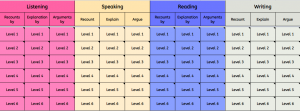The Can Do Descriptors which are similar to the WIDA Language Development Standards, were created to show what students at different levels of proficiency in English should be able to do in each of the four domains. While not a replacement, the Can Do Descriptors are a supplement to the WIDA Standards in instruction.
Each of the tasks are separated into the four areas: reading, writing, speaking, and listening. The descriptors are helpful for making sure ELL students are interacting with the academic content, just at a scaled down to a level that is appropriate to them.
The WIDA Consortium states that educators and early childhood practitioners can also use the Can Do Descriptors in the following ways:
- Collaborate and engage in conversations about language for learning as children and youth move along the continuum of language development
- Understand ACCESS for ELLs test scores
While they were a welcome addition by making instruction aligned with the WIDA Standards easier, the Can Do Descriptors can be overwhelming- especially for new teachers. Michelle Makus Shory and Irina McGrath compiled the descriptors and organized them in a super convenient google sheet!
Take a look:

If you want to modify the document in any way, you will need to make a copy first! We thought this was a fantastic resource and so we wanted to share with you all, enjoy!
Are your students ready for ACCESS?
We previously wrote a blog post on using Extempore for simulated conversations. We discuss how ESL students benefit strongly from simulated conversation practice. Since the test’s speaking portion has gone online, practicing on Extempore is especially useful at preparing students for the exam as it mimics the testing conditions.
Additionally, did you know we have pre-made speaking activities for English? We have created 29 activities that you can import right into your Extempore account! They are currently available in beginner, intermediate, and advanced.


